In this article, we discuss whether there is a factor index that has consistently lower risk than broad-based indices or market capitalisation weighted indices like Nifty 50, 100, 500, etc.
A factor index is an intermediate between an active and a passive strategy. It is rule-based but also passive. The catch is, the rules tend to be arbitrary. See: Data Mining in Index Construction: Why Investors need to be cautious and Why Nifty Midcap150 Quality 50 index performance is a warning for factor investing fans.
We have a low volatility index, and many freefincal readers know that I am a fan of low volatility investing. See, for example, UTI S&P BSE Low Volatility Index Fund Review (I am an NFO investor in this fund).
But does low volatility mean low risk? Low volatility refers to low standard deviation. This means that if you measure the last 12 months’ monthly returns of the low volatility index, the deviation of each individual return from its average is less compared to that of the parent broad-based index.
For example, the Nifty 100 is the parent of the Nifty 100 Low Volatility 30 index. This does not mean the LV index will fall less than the parent when there is a market downturn. That is, low volatility does not guarantee a low drawdown.
Join 32,000+ readers and get free money management solutions delivered to your inbox! Subscribe to get posts via email! (Link takes you to our email sign-up form)
🔥Want to create a complete financial plan? Learn goal-based investing? Exclusive access to our DIY tools? Increase your income with your skills? Use this link to enjoy massive discounts on our robo-advisory tool & courses! 🔥
Low volatility sometimes results in superior returns and almost always produces a better risk-adjusted return than the parent index. Risk-adjusted return is a metric used to evaluate the return relative to the risk taken. The Sharpe ratio, Sortino ratio, and Treynor ratio are examples.
But this does not satisfy many investors. They do not appreciate that low volatility does not mean a low drawdown (fall from a peak). Both are different ways to measure risk in an instrument.
The Ulcer Index is a measure of drawdowns. We have explained this in detail recently – Evaluating mutual fund downside risk with the Ulcer Index. From October 2025, our equity mutual fund screener will use the Ulcer Index as a screening metric.
The lower the drawdown, the lower the Ulcer index and the lower the stress of holding the fund. We compare the Ulcer index of a fund and an index, or one index with another index and create an Ulcer Score. This tells you how consistently the fund has a lower drawdown risk.
If the Ulcer score is high, then the fund or index has had a consistently low drawdown or downside risk.
Nifty 100 TRI vs Nifty 100 Low volatility 30 TRI
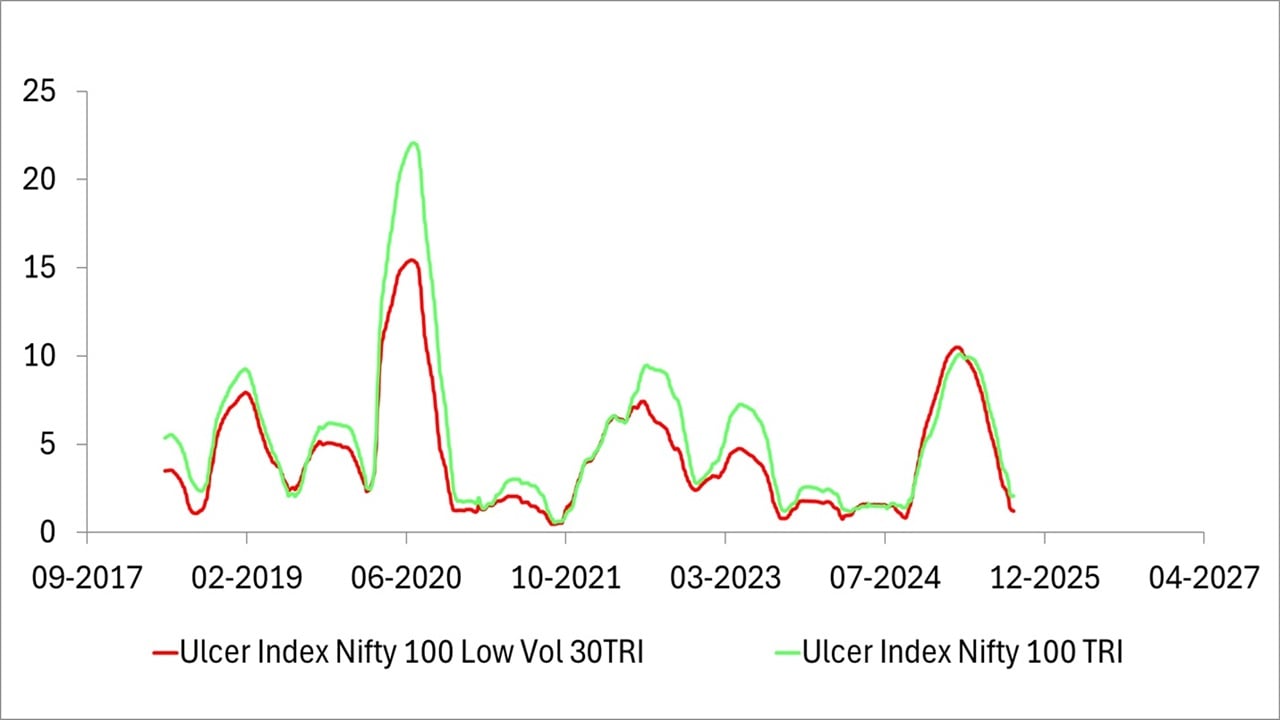
This is over the last 8 years. Sometimes the low volatility index has had a higher drawdown than the parent index (higher Ulcer index). The Ulcer scores tabulated below suggest that while low volatility is not a fool-proof method to get lower drawdowns, the performance is certainly not bad.
| Duration | Ulcer Score NLV30 vs N100 |
| 1 | 100% |
| 2 | 50% |
| 3 | 68% |
| 4 | 78% |
| 5 | 75% |
| 6 | 80% |
| 7 | 79% |
| 8 | 82% |
| 9 | 81% |
| 10 | 76% |
However there is one cavaet. Much of the low volatility index history is backtested and not seen in actual trading. This is a problem with all factor indices.
Can we do better? Is there a simpler index with a consistently lower drawdown than the parent? Yes, all we need to do is replace 35% of the broad-based (equity) index with a broad-based bond index to create an aggressive hybrid index.
We have sung the praises of such an index (no fund tracks this index as of now*)
- Why is diversification the only free lunch in investing?
- We are still waiting for an Aggressive Hybrid Index Fund
- Why we badly need an aggressive hybrid index fund!
* No, a passive FOF is NOT a passive fund! See: Can I invest in Zerodha Multi Asset Passive FoF?
Nifty 100 TRI vs CRISIL 65%-35% Aggressive Hybrid Index
The index comprises the S&P BSE 200 TR (65%) and the CRISIL Composite Bond Fund Index (35%).
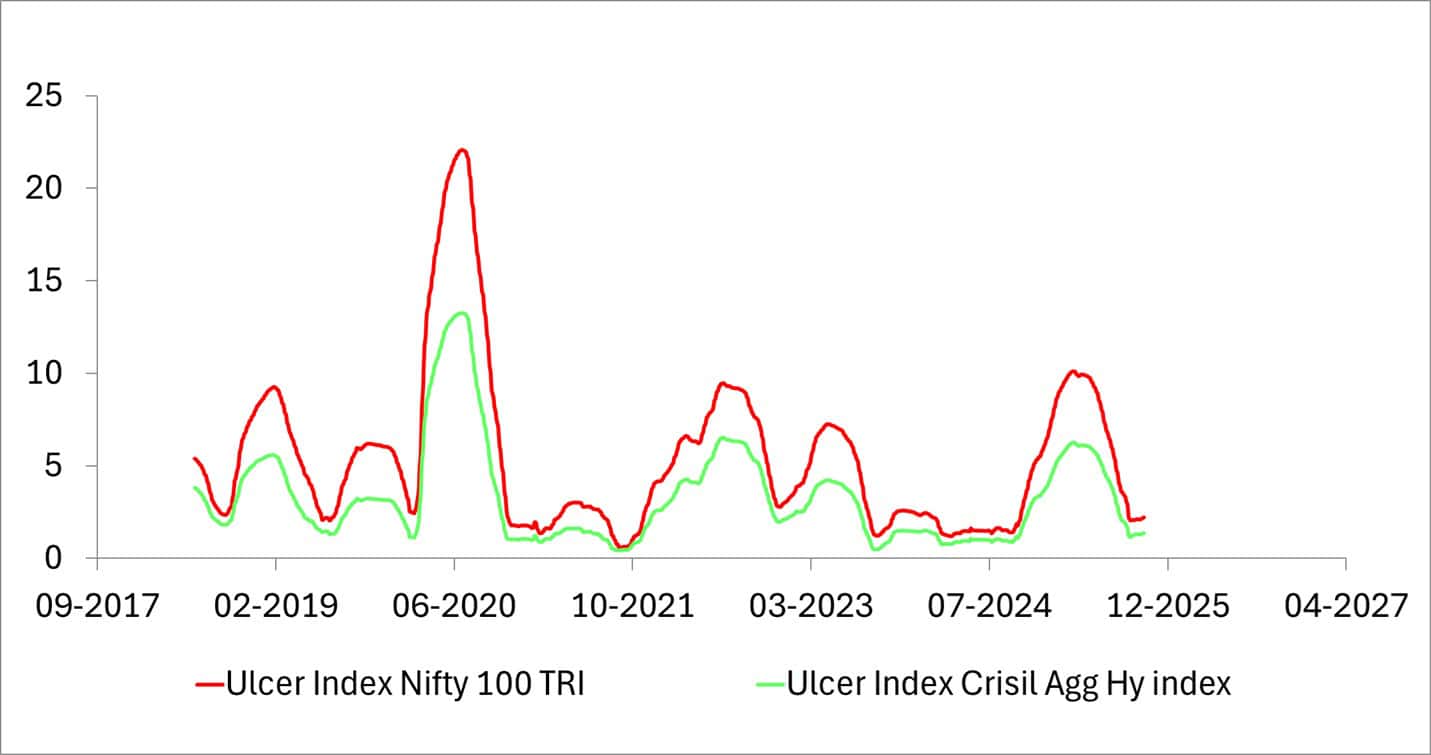
The hybrid index always has a lower Ulcer index than the parent index. The ulcer score for years 1-10 is 100%! The hybrid index will also naturally have a lower volatility!
It is as simple as that, replace a little equity with some bonds, and you have low volatility and low drawdowns – the true free lunch in investing! And it is not even a factor index! It is a simple capitalisation-weighted index! And we still do not have one!
Nifty 100 Low Volatility 30 TRI vs CRISIL 65%-35% Aggressive Hybrid index
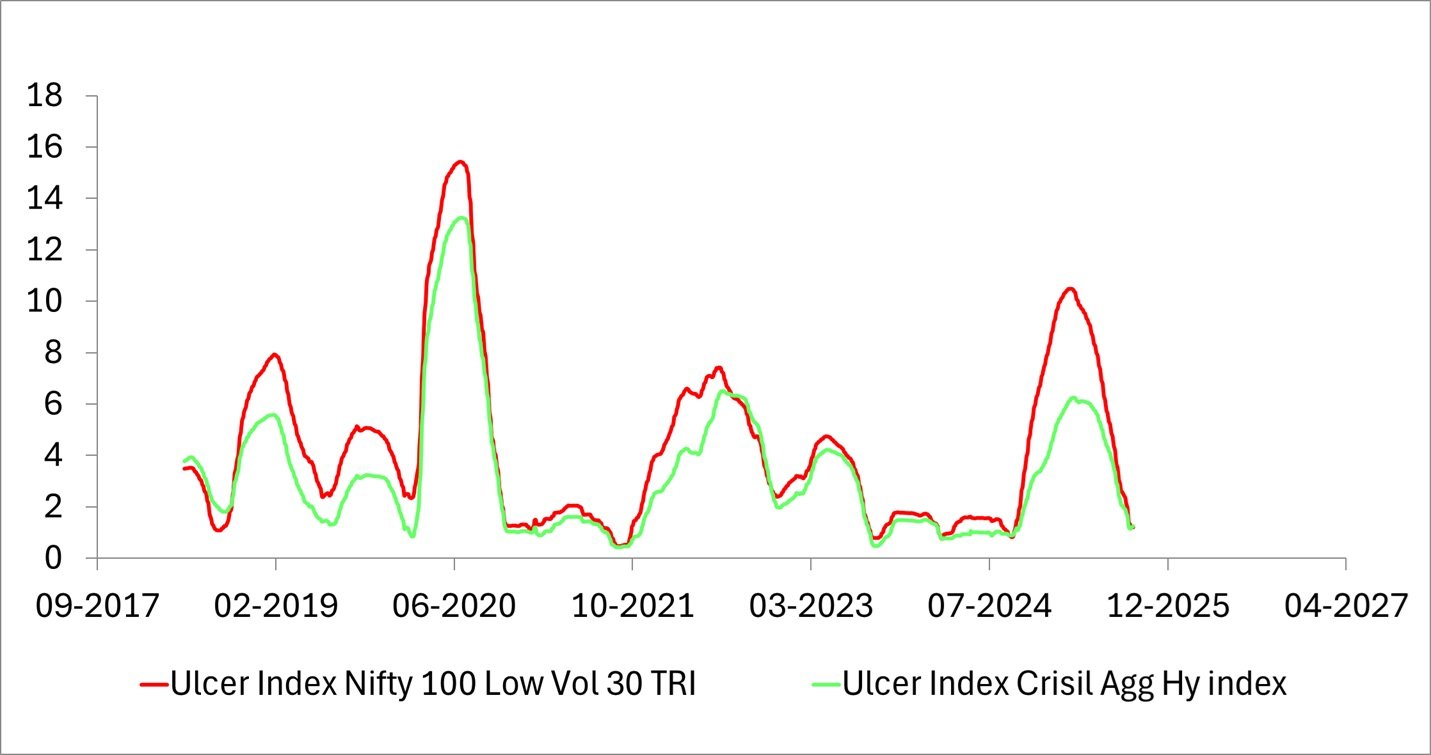
Naturally, the low volatility index has a higher drawdown than the hybrid index, but not as much as the parent Nifty 100.
The Ulcer scores, though, are quite poor.
| Duration | Ulcer Score Low Vol 30 vs Crisl Agg Hy |
| 1 | 3% |
| 2 | 3% |
| 3 | 2% |
| 4 | 11% |
| 5 | 8% |
| 6 | 7% |
| 7 | 6% |
| 8 | 10% |
| 9 | 10% |
| 10 | 9% |
We need simpler indices and index funds that are relatively less stressful. The wait continues.

Use our Robo-advisory Tool to create a complete financial plan! ⇐More than 3,000 investors and advisors use this! Use the discount code: robo25 for a 20% discount. Plan your retirement (early, normal, before, and after), as well as non-recurring financial goals (such as child education) and recurring financial goals (like holidays and appliance purchases). The tool would help anyone aged 18 to 80 plan for their retirement, as well as six other non-recurring financial goals and four recurring financial goals, with a detailed cash flow summary.
🔥You can also avail massive discounts on our courses and the freefincal investor circle! 🔥& join our community of 8000+ users!
Track your mutual funds and stock investments with this Google Sheet!
We also publish monthly equity mutual funds, debt and hybrid mutual funds, index funds, and ETF screeners, as well as momentum and low-volatility stock screeners.
You can follow our articles on Google News

We have over 1,000 videos on YouTube!

Join our WhatsApp Channel

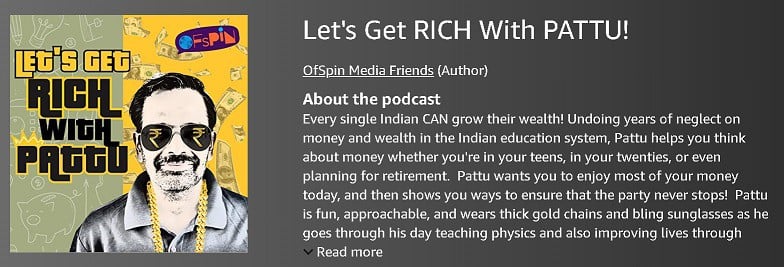

- Do you have a comment about the above article? Reach out to us on Twitter: @freefincal or @pattufreefincal
- Have a question? Subscribe to our newsletter using the form below.
- Hit 'reply' to any email from us! We do not offer personalised investment advice. We can write a detailed article without mentioning your name if you have a generic question.
Join 32,000+ readers and get free money management solutions delivered to your inbox! Subscribe to get posts via email! (Link takes you to our email sign-up form)
About The Author
 Dr M. Pattabiraman (PhD) is the founder, managing editor and primary author of freefincal. He is an associate professor at the Indian Institute of Technology, Madras. He has over 13 years of experience publishing news analysis, research and financial product development. Connect with him via Twitter(X), LinkedIn, or YouTube. Pattabiraman has co-authored three print books: (1) You can be rich too with goal-based investing (CNBC TV18) for DIY investors. (2) Gamechanger for young earners. (3) Chinchu Gets a Superpower! for kids. He has also written seven other free e-books on various money management topics. He is a patron and co-founder of “Fee-only India,” an organisation promoting unbiased, commission-free, AUM-independent investment advice.
Dr M. Pattabiraman (PhD) is the founder, managing editor and primary author of freefincal. He is an associate professor at the Indian Institute of Technology, Madras. He has over 13 years of experience publishing news analysis, research and financial product development. Connect with him via Twitter(X), LinkedIn, or YouTube. Pattabiraman has co-authored three print books: (1) You can be rich too with goal-based investing (CNBC TV18) for DIY investors. (2) Gamechanger for young earners. (3) Chinchu Gets a Superpower! for kids. He has also written seven other free e-books on various money management topics. He is a patron and co-founder of “Fee-only India,” an organisation promoting unbiased, commission-free, AUM-independent investment advice.Our flagship course! Learn to manage your portfolio like a pro to achieve your goals regardless of market conditions! ⇐ More than 3,500 investors and advisors are part of our exclusive community! Get clarity on how to plan for your goals and achieve the necessary corpus no matter the market condition!! Watch the first lecture for free! One-time payment! No recurring fees! Life-long access to videos! Reduce fear, uncertainty and doubt while investing! Learn how to plan for your goals before and after retirement with confidence.
Increase your income by getting people to pay for your skills! ⇐ More than 800 salaried employees, entrepreneurs and financial advisors are part of our exclusive community! Learn how to get people to pay for your skills! Whether you are a professional or small business owner seeking more clients through online visibility, or a salaried individual looking for a side income or passive income, we will show you how to achieve this by showcasing your skills and building a community that trusts and pays you. (watch 1st lecture for free). One-time payment! No recurring fees! Life-long access to videos!
Our book for kids: “Chinchu Gets a Superpower!” is now available!


Must-read book even for adults! This is something that every parent should teach their kids right from their young age. The importance of money management and decision making based on their wants and needs. Very nicely written in simple terms. - Arun.Buy the book: Chinchu gets a superpower for your child!
How to profit from content writing: Our new ebook is for those interested in getting a side income via content writing. It is available at a 50% discount for Rs. 500 only!
Do you want to check if the market is overvalued or undervalued? Use our market valuation tool (it will work with any index!), or get the Tactical Buy/Sell timing tool!
We publish monthly mutual fund screeners and momentum, low-volatility stock screeners.
About freefincal & its content policy. Freefincal is a News Media organisation dedicated to providing original analysis, reports, reviews and insights on mutual funds, stocks, investing, retirement and personal finance developments. We do so without conflict of interest and bias. Follow us on Google News. Freefincal serves more than three million readers a year (5 million page views) with articles based only on factual information and detailed analysis by its authors. All statements made will be verified with credible and knowledgeable sources before publication. Freefincal does not publish paid articles, promotions, PR, satire or opinions without data. All opinions will be inferences backed by verifiable, reproducible evidence/data. Contact Information: To get in touch, please use our contact form. (Sponsored posts or paid collaborations will not be entertained.)
Connect with us on social media
- Twitter @freefincal
- Subscribe to our YouTube Videos
- Posts feed via Feedburner.
Our publications
You Can Be Rich Too with Goal-Based Investing
 Published by CNBC TV18, this book is designed to help you ask the right questions and find the correct answers. Additionally, it comes with nine online calculators, allowing you to create custom solutions tailored to your lifestyle. Get it now.
Published by CNBC TV18, this book is designed to help you ask the right questions and find the correct answers. Additionally, it comes with nine online calculators, allowing you to create custom solutions tailored to your lifestyle. Get it now.Gamechanger: Forget Startups, Join Corporate & Still Live the Rich Life You Want
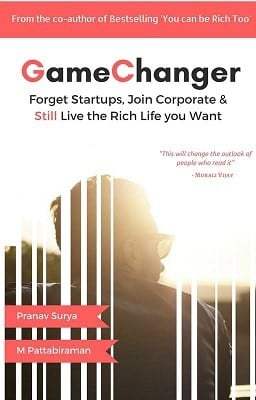 This book is designed for young earners to get their basics right from the start! It will also help you travel to exotic places at a low cost! Get it or gift it to a young earner.
This book is designed for young earners to get their basics right from the start! It will also help you travel to exotic places at a low cost! Get it or gift it to a young earner.Your Ultimate Guide to Travel
 This is an in-depth exploration of vacation planning, including finding affordable flights, budget accommodations, and practical travel tips. It also examines the benefits of travelling slowly, both financially and psychologically, with links to relevant web pages and guidance at every step. Get the PDF for Rs 300 (instant download)
This is an in-depth exploration of vacation planning, including finding affordable flights, budget accommodations, and practical travel tips. It also examines the benefits of travelling slowly, both financially and psychologically, with links to relevant web pages and guidance at every step. Get the PDF for Rs 300 (instant download)